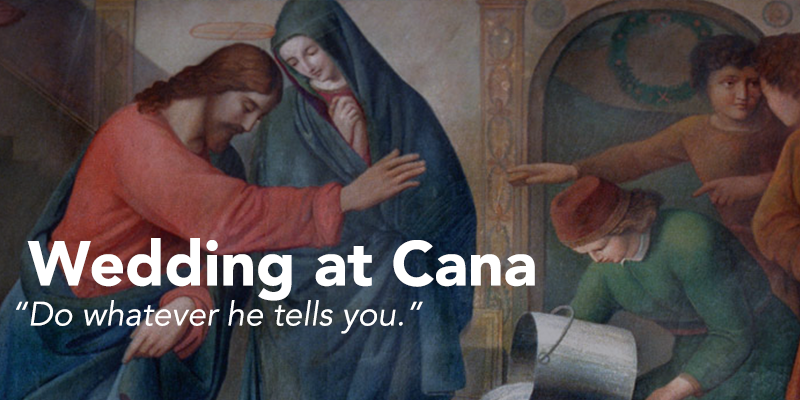First Reading
Isaiah 62:1-5
God delights in Israel and will rejoice as a bridegroom rejoices over his bride.
Responsorial Psalm
Psalm 96:1-2,2-3,7-8,9-10
A song in praise of God’s marvelous deeds
Second Reading
1 Corinthians 12:4-11
All spiritual gifts originate from the same Spirit.
Gospel Reading
John 2:1-11
Jesus performs his first sign at a wedding feast in Cana.
Background on the Gospel Reading
This Sunday we begin the liturgical season of Ordinary Time. For many Sundays in this lectionary cycle (Cycle C), our readings will be taken from the Gospel of Luke. Occasionally, however, we will read from John’s Gospel. This is true of today’s Gospel reading, which describes the beginning of Jesus’ ministry and his first miracle.
To situate today’s reading within the context of John’s Gospel, we note that John’s report of this event follows Jesus’ call of his first disciples. John tells us that Jesus and his disciples were invited to this wedding at Cana, as was Jesus’ mother, Mary. There is no parallel report of this miracle at Cana in the Synoptic Gospels.
In the Church’s liturgical history, the wedding feast of Cana is closely associated with the baptism of the Lord and the adoration of the infant Jesus by the Wise Men. In this context, the sign Jesus performs at the wedding feast is celebrated as an epiphany or a manifestation of Jesus’ divinity.
Yet awareness of Jesus’ impending passion and death is ever present in John’s Gospel. Even in this report of Jesus’ first sign, the language used anticipates Jesus’ passion. When Jesus says to his mother that his hour has not yet come, he protests against her wishes in language that John will use again when reporting Jesus’ Last Supper with his disciples. When introducing the story of Jesus washing his disciples’ feet, John writes that Jesus knew that his hour had come. In John’s Gospel, Jesus is very much in command and aware of all that is to happen to him.
Here, as elsewhere in John’s Gospel, Mary is not mentioned by name, but is referred to instead as the mother of Jesus. Mary is influential in Jesus’ first sign. She will also be present at his Crucifixion, a witness to the final manifestation of his divinity.
John’s Gospel describes seven signs that indicate Jesus’ identity to his disciples. John never speaks of these signs as miracles because their importance is not in the deed that Jesus performs but in what these deeds indicate about Jesus’ identity. Here, as when John describes the other signs, the disciples are said to begin to believe, but no mention is made as to whether the other wedding guests are even aware of what has happened.
Marriage and wedding feasts are metaphors used in Scripture to describe God’s salvation and the Kingdom of God. Here at the beginning of Jesus’ public ministry, John’s Gospel seeks to establish that Jesus is going to re-interpret and fulfill Yahweh’s promise to Israel. Jesus establishes the New Covenant. A hint about what this New Covenant will be like is made evident in the deed that Jesus performs. Asked to do something to address the awkward situation that the absence of wine at a wedding feast would create, Jesus’ miracle produces vast quantities of wine—six jars holding thirty gallons each are filled to overflowing with choice wine.
This lavish response to a simple human need is a vision for us of the abundance of God’s kingdom. It challenges us to respond generously when confronted with human need today. We respond as best we can, fully confident that God can transform our efforts, bringing the Kingdom of God to fulfillment among us.

